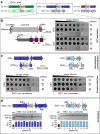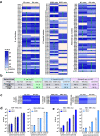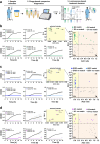Engineered reporter phages for detection of Escherichia coli, Enterococcus, and Klebsiella in urine
- PMID: 37474554
- PMCID: PMC10359277
- DOI: 10.1038/s41467-023-39863-x
Engineered reporter phages for detection of Escherichia coli, Enterococcus, and Klebsiella in urine
Abstract
The rapid detection and species-level differentiation of bacterial pathogens facilitates antibiotic stewardship and improves disease management. Here, we develop a rapid bacteriophage-based diagnostic assay to detect the most prevalent pathogens causing urinary tract infections: Escherichia coli, Enterococcus spp., and Klebsiella spp. For each uropathogen, two virulent phages were genetically engineered to express a nanoluciferase reporter gene upon host infection. Using 206 patient urine samples, reporter phage-induced bioluminescence was quantified to identify bacteriuria and the assay was benchmarked against conventional urinalysis. Overall, E. coli, Enterococcus spp., and Klebsiella spp. were each detected with high sensitivity (68%, 78%, 87%), specificity (99%, 99%, 99%), and accuracy (90%, 94%, 98%) at a resolution of ≥103 CFU/ml within 5 h. We further demonstrate how bioluminescence in urine can be used to predict phage antibacterial activity, demonstrating the future potential of reporter phages as companion diagnostics that guide patient-phage matching prior to therapeutic phage application.
© 2023. The Author(s).
Conflict of interest statement
S.K., M.D., and J.B. are employees of Micreos GmbH and M.J.L. is a scientific advisor to Micreos GmbH. The remaining authors declare no competing interests.
Figures






References
-
- Eliakim-Raz N, et al. Risk factors for treatment failure and mortality among hospitalized patients with complicated urinary tract infection: a multicenter retrospective cohort study (RESCUING Study Group) Clin. Infect. Dis. 2019;68:29–36. - PubMed
Publication types
MeSH terms
Substances
LinkOut - more resources
Full Text Sources
Medical
Research Materials
Miscellaneous

